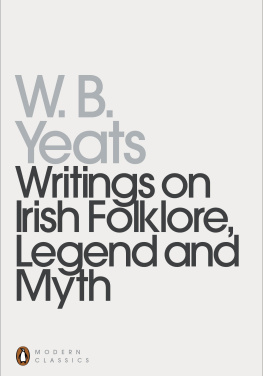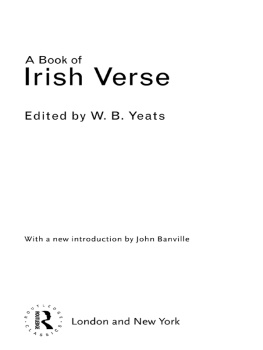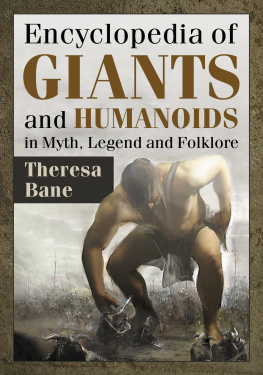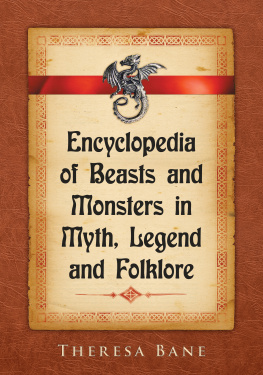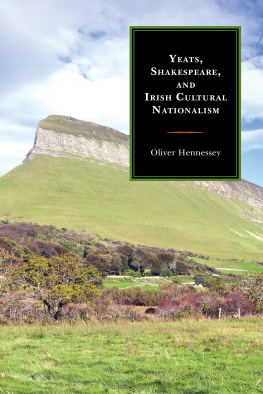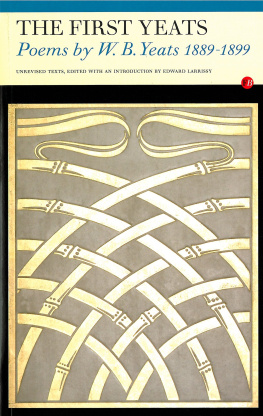William Yeats - Writings on Irish Folklore, Legend and Myth
Here you can read online William Yeats - Writings on Irish Folklore, Legend and Myth full text of the book (entire story) in english for free. Download pdf and epub, get meaning, cover and reviews about this ebook. year: 1993, publisher: Penguin UK, genre: Detective and thriller. Description of the work, (preface) as well as reviews are available. Best literature library LitArk.com created for fans of good reading and offers a wide selection of genres:
Romance novel
Science fiction
Adventure
Detective
Science
History
Home and family
Prose
Art
Politics
Computer
Non-fiction
Religion
Business
Children
Humor
Choose a favorite category and find really read worthwhile books. Enjoy immersion in the world of imagination, feel the emotions of the characters or learn something new for yourself, make an fascinating discovery.
- Book:Writings on Irish Folklore, Legend and Myth
- Author:
- Publisher:Penguin UK
- Genre:
- Year:1993
- Rating:4 / 5
- Favourites:Add to favourites
- Your mark:
- 80
- 1
- 2
- 3
- 4
- 5
Writings on Irish Folklore, Legend and Myth: summary, description and annotation
We offer to read an annotation, description, summary or preface (depends on what the author of the book "Writings on Irish Folklore, Legend and Myth" wrote himself). If you haven't found the necessary information about the book — write in the comments, we will try to find it.
Writings on Irish Folklore, Legend and Myth — read online for free the complete book (whole text) full work
Below is the text of the book, divided by pages. System saving the place of the last page read, allows you to conveniently read the book "Writings on Irish Folklore, Legend and Myth" online for free, without having to search again every time where you left off. Put a bookmark, and you can go to the page where you finished reading at any time.
Font size:
Interval:
Bookmark:
PENGUIN TWENTIETH-CENTURY CLASSICS
WRITINGS ON IRISH FOLKLORE, LEGEND AND MYTH
William Butler Yeats was born in Dublin in 1865 into an artistic family and spent his childhood in Sligo, Dublin and London. In Dublin he enrolled at the Metropolitan School of Art in 1884. The next year he became a founder-member of the Dublin Hermetic Society; in time this led him to the Esoteric Section of the Theosophical Society and the Hermetic Order of the Golden Dawn (1890). He developed a life-long interest in magic, the occult and the supernatural, which influenced much of his thinking and writing, and which achieved its most complete expression in the expository speculations of A Vision (1925; revised version 1937).
Yeatss home was most often in London, though he visited Ireland frequently. For a while he was close to the politics of Irish nationalism, not least because of his long infatuation with the revolutionary Maud Gonne, to whom he unsuccessfully proposed on many occasions. From an early stage, he devoted his energies much less to direct political action than to the cause of an imaginative nationalism which involved him in the collection of folklore (notably in The Celtic Twilight, 1893), in the creation and management of a national theatre for which he wrote a body of plays (five of which presented the epic hero Cchulainn), and in the critical reinterpretation and advancement of the Irish literary tradition.
In 1915 Yeats refused a knighthood from the British government; in 1922 he became a Senator of the newly founded Irish Free State, and finally settled in Dublin with Georgie Hyde-Lees, whom he had married in 1917 and whose automatic writing became the basis of A Vision. In 1917 he also purchased a Norman stone tower in Ballylee, Co. Galway, and this provided the symbolic focus for The Tower (1928) which is, perhaps, his richest collection of poetry. Yeats left a vivid record of his life and of his friends and acquaintances in the volumes which were collected as Autobiographies and in the franker Memoirs (not published until 1972). He died at Roquebrune, France, in January 1939.
Robert Welch is Professor of English at the University of Ulster, Coleraine. He has published Irish Poetry from Moore to Yeats (1980), A History of Verse Translation from the Irish (1988) and Changing States: Transformations in Modern Irish Literature (1993). He is the editor of The Oxford Companion to Irish Literature and was chairman of the International Association for the Study of Anglo-Irish Literature from 1988 to 1991. He has edited a number of volumes of essays, and a book of his poems, Muskerry, appeared in 1991. He is married with four children and lives in Portstewart.
Timothy Webb is General Editor for the works of W. B. Yeats in Penguin Twentieth-Century Classics.
W. B . YEATS
_____________
WRITINGS ON IRISH FOLKLORE,
LEGEND AND MYTH
EDITED WITH AN INTRODUCTION
AND NOTES BY ROBERT WELCH

PENGUIN BOOKS
PENGUIN BOOKS
Published by the Penguin Group
Penguin Books Ltd, 80 Strand, London WC2R 0RL, England
Penguin Putnam Inc., 375 Hudson Street, New York, New York 10014, USA
Penguin Books Australia Ltd, 250 Camberwell Road, Camberwell, Victoria 3124, Australia
Penguin Books Canada Ltd, 10 Alcorn Avenue, Toronto, Ontario, Canada M4V 3B2
Penguin Books India (P) Ltd, 11 Community Centre, Panchsheel Park, New Delhi 110 017, India
Penguin Books (NZ) Ltd, Cnr Rosedale and Airborne Roads, Albany, Auckland, New Zealand
Penguin Books (South Africa) (Pty) Ltd, 24 Sturdee Avenue, Rosebank 2196, South Africa
Penguin Books Ltd, Registered Offices: 80 Strand, London WC2R 0RL, England
www.penguin.com
This edition first published in Penguin Books 1993
This edition copyright Robert Welch, 1993
The Midnight Court is reprinted with the permission of Scribner, a division of Simon & Schuster, Inc., from Explorations by W. B. Yeats. Copyright 1962 by Mrs W. B. Yeats
Compulsory Gaelic and The Great Blasket are reprinted with the permission of Scribner, a division of Simon & Schuster, Inc., from THE COLLECTED WORKS OF W. B. YEATS, Vol. X, edited by Colton Johnson. Writings by W. B. Yeats copyright 2000 by Anne and Michael Yeats. Editorial matter copyright 2000 by Colton Johnson.
All rights reserved
The moral right of the editor has been asserted
Except in the United States of America, this book is sold subject to the condition that it shall not, by way of trade or otherwise, be lent, re-sold, hired out, or otherwise circulated without the publishers prior consent in any form of binding or cover other than that in which it is published and without a similar condition including this condition being imposed on the subsequent purchaser
ISBN: 978-0-14-196099-9
I would like to thank the British Academy for a personal research grant, which allowed me to undertake research at the British Library; the Research Subcommittee of the Faculty of Humanities, University of Ulster, under its chairman, Dr John Gillespie, for its assistance; Professor Peter Roebuck; Professor A. N. Jeffares; Dr John Kelly; Dr John Pitcher; Professor Timothy Webb, for guidance and encouragement; Dr Bruce Stewart; Dr Lis Lillie; Mr Philip Tilling; Mr Brian Baggett; Dr Rory McTurk; Dr Daith hgin; Mr Alan Peacock; Van Morrison, for his kind permission to reproduce a verse from Beautiful Vision; Donna Poppy at Penguin; Mrs Elizabeth Holmes; and Mrs Mary McCaughan.
This volume consists of all of Yeatss discursive published writings on Irish folklore, legend and myth, where these topics constitute the main subject of the essay, introduction or sketch. It excludes poetry, drama and prose fiction based on this material, and incidental discussion of it in occult works such as A Vision or in the autobiographical writings. The great bulk of the work presented here was written between 1887 and 1904, the years during which he familiarized himself with Irish tradition, particularly in its folk and legendary aspects. These writings reveal the development of a critical, analytical, and interpretative approach to Irish tradition during this period in particular, but extending beyond it to 1933, when he considered again the scope and quality of life on the islands off the west coast of Ireland. At the outset, as in the discussion and classification of fairies in the late 1880s, there is analysis and youthful fascination, which develops, throughout the 1890s, into a world view of considerable psychological and philosophical depth; until, in the 1900s, this material, and the spiritual, intellectual and cultural interests it generated, became part of the quality of awareness deployed in all his writings.
A pattern of developing complexity is evident in the writings gathered here, for which reason it was decided to present them chronologically, in the order of publication. This decision might seem to involve a major disadvantage: The Celtic Twilight in its two overlapping versions (1893 and 1902) is not presented as a unified text; rather the constituent elements out of which it was originally assembled (on two occasions) are given as they were first printed in newspapers and magazines, thus allowing the reader a clear sense of Yeatss persistent intellectual toil on his material and his increasing mastery of it. The contents of both editions of The Celtic Twilight are given in an appendix. This chronological guideline is breached in a few instances: the note on The Valley of the Black Pig is given in its fullest, not its earliest, form; and in a number of other cases a later version develops an incidental sketch into a free-standing piece, and where this occurs the latter is preferred.
Font size:
Interval:
Bookmark:
Similar books «Writings on Irish Folklore, Legend and Myth»
Look at similar books to Writings on Irish Folklore, Legend and Myth. We have selected literature similar in name and meaning in the hope of providing readers with more options to find new, interesting, not yet read works.
Discussion, reviews of the book Writings on Irish Folklore, Legend and Myth and just readers' own opinions. Leave your comments, write what you think about the work, its meaning or the main characters. Specify what exactly you liked and what you didn't like, and why you think so.

